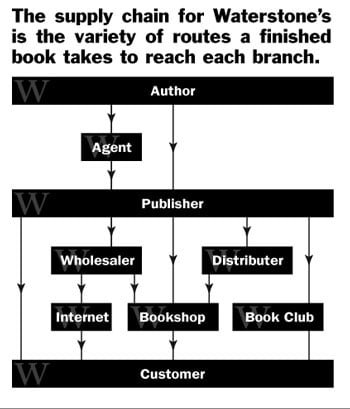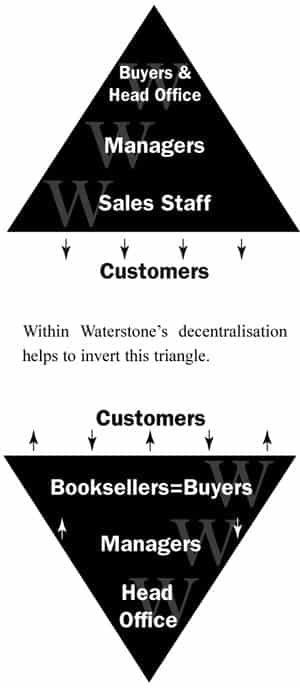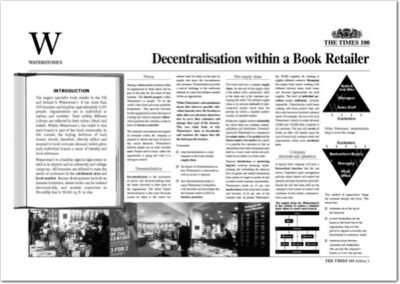The largest specialist book retailer in the UK and Ireland is Waterstone’s. It has more than 200 branches and employs approximately 4,200 people. Organisations are as individual as nations and societies. Their widely different cultures are reflected in their values, ideals and beliefs. Within Waterstone’s, the belief is that each branch is part of the local community. In this context, the buying decisions of each branch should, therefore, directly reflect and respond to local customer demand, which gives each individual branch a sense of identity and local relevance.
Waterstone’s is a familiar sight in high streets as well as in airports and on university and college campuses. All branches are tailored to meet the needs of customers in the catchment area and local market. Recent developments include an Internet bookstore, where books can be ordered electronically, and another superstore in Piccadilly that is 56,000 sq. ft. in size.
Vision
Sharing a vision enables everyone within an organisation to think ahead and be part of the plan for the future of that business. The shared purpose within Waterstone’s is simple, “To be the world’s best loved and most profitable Booksellers”. This provides direction for the organisation to form the basis of a strong and vibrant company culture, which positions the customer as key in terms of business priorities.
The complete commitment and support of everyone within the company is required to deliver the kind of service this vision demands. Waterstone’s believes people are its most valuable asset. People need to know where the organisation is going and what it is aiming to achieve.
Decentralisation
Decentralisation is the movement of power and decision-making from the centre outwards to other parts of the organisation. The belief behind decentralisation is that most decisions cannot be taken at the centre but instead must be taken on the spot by people who know the circumstances and customers. Decentralisation provides a radical challenge to the traditional methods of control and influence exerted within an organisation.
Within Waterstone’s, decentralisation means that wherever possible, individual branches have the freedom to make their own decisions about how best to serve their customers and manage their part of the business. This case study looks at why Waterstone’s chose to decentralise and examines the impact that this has had upon the business. It examines:
- why decentralisation is a key response to the book industry supply chain
- the impact of decentralisation on how Waterstone’s is structured as well as on how it operates
- how decentralisation helps to equip Waterstone’s booksellers with the skills and knowledge that the business needs to fulfil its business priorities.
The supply chain
The book trade has a complex supply chain. At one end of the supply chain is the author with a manuscript, while at the other end is the customer purchasing the book. The industry supply chain is an intricate network of interconnected parties which form the process by which a finished product reaches its intended market.
Books are a highly creative commodity for which there are countless authors, publishers and distributors. Decentralisation for Waterstone’s is a response to the unique nature of the product and the diverse nature of the market. As a result, it is possible for customers to find an international best-seller sharing the same shelf as a local work written and published by an author in a front room.
Logistics
Physical distribution or marketing logistics involves planning, implementing and controlling the physical flow of goods and related information from points of origin to points of sale in order to meet customer requirements. Waterstone’s holds an 18 per cent market share of the book retail market and between 12-14 per cent of the industry total. At present Waterstone’s has 30,000 suppliers all working to slightly different contracts. Managing the supply chain means working with different delivery times, trade terms and discount opportunities for each supplier. The level of individual specialism makes uniformity virtually impossible.
Centralisation would mean working with fewer product lines and this would not serve localised customer needs. For example, the aim is for each Waterstone’s branch to make between 50,000 and 150,000 titles available to its customers. The mix and variety of books on offer will depend upon the size of branch and customer needs and requirements within each catchment area.
Organisational structure

A typical retail company will have a hierarchical structure like the one shown. Dependent upon management policies, senior buyers will control the quantity and type of products provided, despite the fact that sales staff are the company’s direct point of contact with customers. In this model, communication is one way. Within Waterstone’s decentralisation helps to invert this triangle. This method of organisation brings the customer sharply into focus. This means that:
- customers are at the top of the hierarchy
- as local booksellers are the buyers at the front-line of the organisation, they are best placed to respond accurately and immediately to customers’ needs
- communication between customers and booksellers, who are also the company’s buyers, is a two way process.
Career Development Framework (CDF)

In order to equip booksellers to meet this pivotal role, Waterstone’s has developed the Career Development Framework to develop and reward the skills, values and attitudes of its staff. The framework covers six key areas of the business at branch level including
customer service, business awareness, stock management, team development, security and health and safety. The framework consists of the ‘five stages of bookselling’
Stage 1
Bookseller (Core Skills)
Stage 2
Bookseller (Development)
Stage 3
Senior Bookseller (Core skills)
Stage 4
Senior Bookseller (Development)
Stage 5
Senior Bookseller
(Preparation for Management).
These stages enable individual employees to set objectives that improve staff performance as they move through pay points and their skills are acquired and developed. Personal, team and company objectives encourage individuals to be flexible and dynamic in thinking about how to improve the customer service they offer in order to satisfy individual and local needs.
Starting a career as a bookseller
One element of the Career Development Framework is Waterstone’s unique approach to stock management. The hallmark of decentralisation is the concept of ‘freedom to act’. This means that booksellers are actively involved in making day-to-day decisions within the business. From the start of their career each bookseller is given responsibility for a number of sections within their branch, such as fiction, history, politics or travel literature. At a basic level this means that they ensure that the sections are tidy, well-ordered and customer friendly. As they become more experienced, they become directly responsible for monitoring stock quality, display and presentation, controlling budgets and marketing each section.
Career development
Stage 1
A new bookseller will be ‘buddied’ with a colleague through a mentorship. This shared experience enables them to learn the skills of stock management during the first stage.
They will be shown how to use Waterstone’s sales and stock database. This system is called Phoenix and booksellers use the information it provides to check the sales of titles in their sections. Phoenix is an Electronic Point Of Sales (EPOS) system, which records the sales history of every book sold in a branch on a certain day. For example, if two copies of a book have sold, Phoenix will offer a recommended order quantity of two. However, the decision to reorder a particular title, and in what quantity, is dependent upon many factors. This is where a bookseller’s individual judgment and specialist knowledge are invaluable. As part of their developing experience they would have to consider:
- how well the title has sold in the past
- the number of customer enquiries about the book
- whether it had been reviewed recently in newspapers and magazines, as well as whether it
- had been the subject of media interest or television coverage
- if it was part of an in-store promotion
- whether it was in the national best-seller lists.
The fact that booksellers draw upon their wider knowledge and have the power and freedom to act upon it, is crucial to the concept of decentralisation as it:
- allows branches to respond fully to the needs of customers and local markets
- enables branches to run with optimum stock levels. This means that the right quantity of books are in stock and that these are available when customers want to buy them.
Stage 2
Each phase of the Career Development Framework builds upon and consolidates the skills and learning acquired at previous stages. Once the principles and practices behind everyday stock replenishment have been mastered, a Stage 2 bookseller will begin to develop skills around buying new titles for their sections from publisher’s representatives. As booksellers are constantly in contact with customers and listen to their thoughts and recommendations, they are aware of changing views and the current demand for certain areas. This feedback creates market focus as it enables booksellers to develop their range of sections in a way which is tailored to the profile of their local customer base.
Stage 3
During this phase, senior booksellers are encouraged to develop the leadership skills necessary for branch management. At this level, it is important that the skills of individuals around stock management are located within the wider context of the branch, as well as the values of Waterstone’s and the culture of the company. One of the ways in which Stage 3 booksellers can increase their knowledge in this area is by organising local promotions, such as ‘Branch Bestsellers’ or ‘booksellers Choice’. These are good ways of combining the enthusiasm of the bookseller with the interests of their customers.
Waterstone’s draws the attention of its customers to new titles and promotions through table displays. By working with the marketing department at Head Office, individual booksellers can produce their own leaflets, banners and table signs. This is a clear and active way of signposting titles that have been generated by local demand.
Stages 4 and 5
During stages 4 and 5, senior booksellers are responsible for co-ordinating branch events such as author signings, reading groups or school visits. This provides an opportunity to build community links and obtain first-hand feedback from customers. Booksellers can negotiate greater discount for stock sold at events and also decide upon the best way to use publicity opportunities for the good of their branch.
Conclusion
Supported by the Career Development Framework, decentralisation has enabled employees within Waterstone’s to focus their work upon the needs of their customers. It has also empowered each individual to make his/her own contribution, not just to the success of the branch, but also to the business as a whole.
 Decentralisation within a book retailer (PDF)
Decentralisation within a book retailer (PDF) 